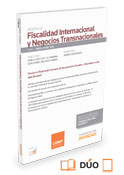On this time of the year, many of us prepare to go on family vacation and disconnect from the daily stress of the office. Most of us prepare a list of interesting books or movies to catch-up on our hot summer relaxing days. Just as we are dreaming about the summer breeze, Uncle Sam emerges with outlandish tax positions.

Two major events took place in June and July from US international tax standpoint:
1- New set of regulations regarding global intangible low-taxed income ("GILTI") rules were released, and
2- The US Senate, finally after more than 9 years, ratified four new treaties protocol – among them the US-Spain protocol.
In this paper, we would like to present very briefly some key elements on the final GILTI regulations as they have important impact on US international tax planning. To be noted that said regulations are extremely voluminous. It would impossible for us to explain in detail each point. For this reason, we refer the reader to the Federal Register for further information[1]. Our intent is to present the most important points mainly discussed in the tax community. GILTI rules present various complicated concepts that deserve to be reviewed in detail, which is not the purpose of present article.
On June 21, 2019, the United States Treasury Department ("USTD") and the Internal Revenue Service ("IRS") published two wide and long sets of public regulations on GILTI under Internal Revenue Code ("IRC") Section 951A and proposed regulations on subpart F income under Section 951, impacting once more the US international tax system.
Historically, the Revenue Act of 1962 codified the Subpart F regime limiting deferral of US taxation on some types of investment income arising from a controlled foreign corporation ("CFC"). In December 22, 2017 the provision added by Pub. L. 115-97, referred to as Tax Cuts and Jobs Act ("TCJA") was enacted and its purpose was to retain the existing subpart F regime that applies to passive income and related-party sales and services. It also created a new type of inclusion for GILTI, which is based on a broad class of CFC income. It must be noted that the GILTI regime prevents high-value activities and assets in low-tax jurisdictions for taxpayers.
A CFC is generally a non-U.S. corporation where more than 50% of the stock (based on aggregate voting or value) is owned by U.S. shareholders. A U.S. shareholder is a U.S. taxpayer who owns the shares representing at least 10% of the votes or value of all stock of the corporation.
TCJA enacted Section 951A, which generally aims to limit deferral of US tax on the active business income of CFC to the extent that income is taxed by non-US jurisdictions at low tax rates. The GILTI rules target income other than a CFC's investment income, subtracting certain types of enumerated income. The GILTI rules, require a US Shareholder in a CFC to include in gross income its pro-rata share GILTI income.
The final regulations retain the basic approach and structure of the proposed regulations and foreign tax credit proposed regulations with certain revisions.
The Hypothetical distribution of Allocable E&P rules (The pro-rata share):
A US shareholder's pro-rata share of subpart F income as to CFC tax year is generally based on a "proportionate share of a hypothetical distribution" of the CFC's earnings and profits ("E&P") generated. The final regulations adopt a narrow anti-abuse rule that applies based on the shares of CFC stock outstanding as of a given hypothetical distribution date. The final anti-abuse rule applies only to transactions undertaken with a main purpose of avoiding US tax by altering the amount of "allocable E&P" that an outstanding share of CFC stock would have been deemed to receive in a hypothetical distribution. In such case, the transaction would be disregarded in determining pro-rata shares of relevant items considered in determining a US shareholder's subpart F income or GILTI amount.
Gross Income excluded by reason of Section 954(b)(4) rules (GILTI high tax exclusion):
The proposed GILTI regulations would generally allow taxpayers to elect a "high tax exclusion" that would exclude from a US shareholder's GILTI inclusion items of income of its CFCs that would otherwise be part of the GILTI inclusion. This GILTI high tax exception is applicable to items of gross income that are excluded from foreign base company income or insurance income by reason of an election under 954(b)(4).
Treatment of domestic partnerships rules:
As a base of the hybrid approach, a US person who is a partner of a domestic partnership owning stock in a CFC, the final GILTI regulations treat the domestic partnership as foreign, requiring the US partner to account directly for the GILTI items. However, the domestic partnership can still constitute a US shareholder of the CFC and the foreign corporation can still constitute a CFC because of the domestic partnership. As a result, the GILTI inclusion would be directly to the US partners for which the inclusion is required.
The proposed subpart F income regulations would extend this treatment to determining the US shareholders that must include subpart F income with respect to a CFC.
Calculation of GILTI inclusion Amount – Consolidated Section 951(1)(A) rules:
The final regulations apply the aggregation approach that has the effect of determining the aggregate amount of GILTI inclusion amounts of members on a single-entity basis, but then determining each member's share of the consolidated group's aggregate GILTI inclusion amount based on its relative pro rata share of tested income as determined on a separate-entity basis
This approach effectively makes the location of CFCs with such items generally irrelevant Notwithstanding this single-entity approach, the relevant Section 958(a) shareholder is the member, not the group where the inclusion is at the member-level.
Gross Income Taken into account in determining subpart F Income rules:
The final GILTI regulations confirm that subpart F income resulting from Section 952(c)(2) recapture is not gross income considered in determining subpart F income, which means that gross tested income can give rise to both subpart F income and tested income in the same tax year. The final GILTI regulations also provide however, that reductions to subpart F income because of qualified deficits or chain deficits do not increase gross tested income
Various anti-abuse rules presented:
The final regulations include distinct anti-abuse rules. In each case, the final GILTI regulations modify an anti-abuse rule that was included in the original proposed regulations. The most important in our view are the following:
1- Specified tangible property held temporarily: The anti-abuse rule for temporarily held property in the proposed regulations included a "per se" rule, which deemed property to be held temporarily and acquired with a principal purpose of reducing a GILTI inclusion amount if held by the CFC for less than a 12-month period.
The final regulations also include a "safe harbor" that generally applies to transfers of property between teste income CFCs that meet certain conditions. Also, the final GILTI regulations provide a presumption that property held for less than 12 months was acquired with a principle purpose of decreasing GILTI. The final GILTI regulations also include a presumption that property held for more than 36 months was not acquired with a principle purpose of decreasing GILTI.
2- Transfers during the disqualified period rules: it applies to compute QBAI and generally disregards basis resulting from transfers from 1 January 2018, through the effective date of the GILTI provisions for fiscal-year taxpayers. Consistent with the original proposed regulations, the final GILTI regulations permit the amount of disqualified basis to be reduced or eliminated through depreciation or taxable sales or exchanges. For sales to related parties, however, the final regulations now provide that the amount of disqualified basis retains its character as such in the hands of the related purchaser. Further, the disqualified basis can also be replicated or carried over to other property in non-recognition transfers. The final regulations offer some relief this rule in the form of an election to eliminate the disqualified basis for all purposes. The election must be made for all related CFCs and partnerships that hold property with disqualified basis. In addition, any return that has already been filed that is inconsistent with the elimination of the disqualified basis must be amended.
The final and the proposed GILTI regulations present tax opportunities and tax challenges for taxpayers. The changes in the final regulations would need to be addressed in short order for companies that have not yet filed their 2018 tax returns. To be noted that all related forms have been amended as well, where much more detailed information is required. Taxpayers must know that compliance will require more time consuming and must anticipate an increase in their professional fees.
[1] https://www.federalregister.gov/documents/2019/06/21/2019-12437/guidance-related-to-section-951a-global-intangible-low-taxed-income-and-certain-guidance-related-to
International Tax Manager



